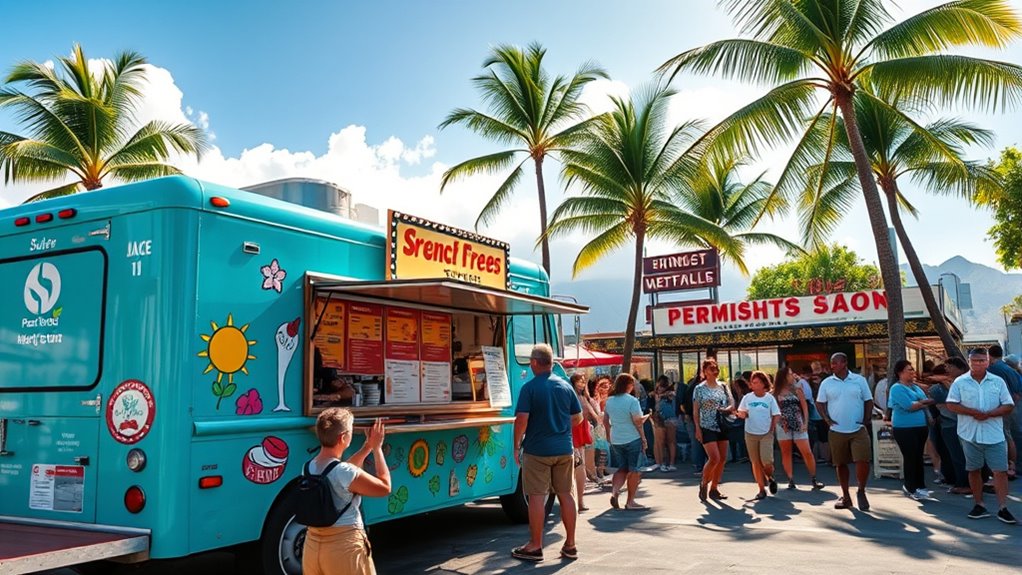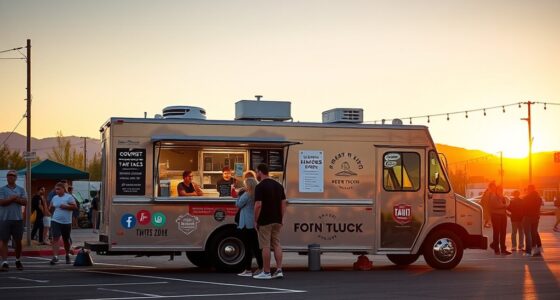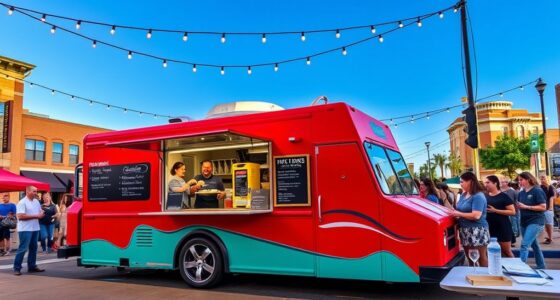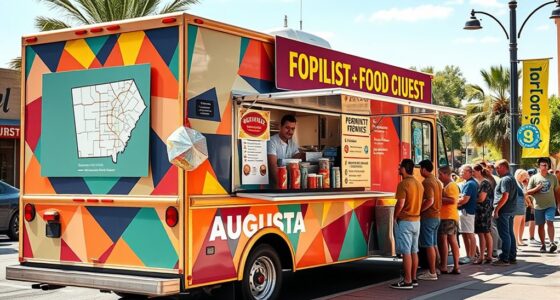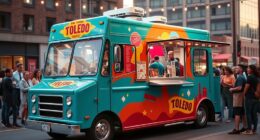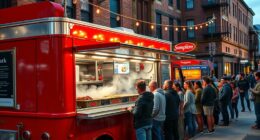To open a food truck in Honolulu, you’ll need essential permits like a business license (~$20), health and safety permits, and possibly a liquor license depending on your offerings. Expect startup costs between $40,000 and over $200,000, including truck purchase, equipment, and permits. Prime spots include busy beaches, tourist areas, and main streets. Focus on local flavors and strong marketing through social media. If you keep exploring, you’ll uncover more tips to start and grow your Hawaiian food truck.
Key Takeaways
- Obtain necessary permits including a Hawaii business license, driver’s license, liquor license, and health permits, with costs ranging from $20 to over $1,200.
- Budget $40,000 to over $200,000 for truck purchase, setup, permits, initial inventory, branding, and marketing expenses.
- Choose high-traffic, scenic, and tourist-frequented locations like Haleiwa streets, beaches, and event venues, ensuring zoning compliance.
- Develop a menu emphasizing local flavors with native ingredients, Hawaiian spices, and vegetarian options to attract diverse customers.
- Utilize social media advertising, engaging content, and reviews to attract customers and grow your food truck business in Honolulu.
Navigating Permits and Regulatory Requirements in Honolulu

Navigating permits and regulatory requirements in Honolulu can seem complex, but understanding the key steps makes the process manageable. First, you need a Hawaii state business license, which costs around $20, obtained through Hawaii Business Express. Register for your state tax accounts, including general excise and use taxes, with no fee. If you plan to hire employees, set up an employer tax withholding account at no cost. You’ll also need a valid driver’s license, which costs $20 to $40, to operate your truck. If selling alcohol, apply for a liquor license through the County Department of Liquor Control, with fees from $150 to $1,200. Ensuring you meet health and safety permits, parking restrictions, and vehicle standards is essential before launching your food truck. Additionally, local zoning laws may restrict where you can park and operate your food truck, so consulting with local authorities is recommended. Being aware of juice cleanse and detox guidelines can also be beneficial if you plan to include healthy beverage options in your menu, as they involve understanding health regulations and consumer safety.
Estimating Startup and Operating Expenses for Your Food Truck
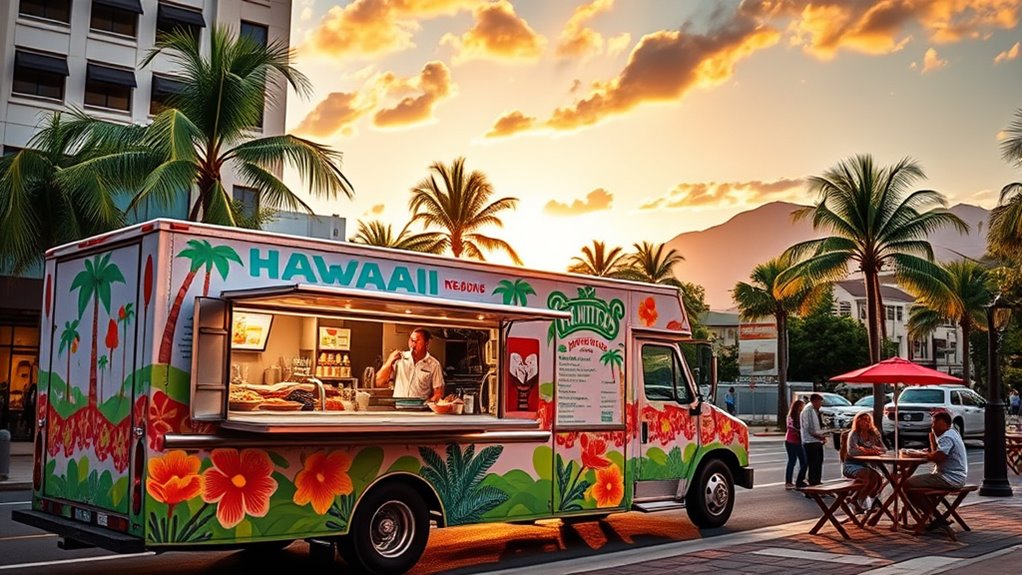
Understanding your startup and ongoing expenses is key to launching a successful food truck in Honolulu. Your initial investment can range from $40,000 to over $200,000, depending on the truck’s condition and size. A new truck in Hawaii typically costs $50,000–$150,000, with additional setup costs for kitchen equipment between $500 and $80,000. You’ll also need $1,000–$10,000 for initial inventory and $5,000–$15,000 for permits and licenses. Branding and marketing expenses may add another $3,000–$8,000. Ongoing costs include inventory replenishment (25–35% of revenue), fuel ($500–$1,000/month), insurance, wages, and utilities. Budget for staff training, marketing efforts, and promotional events to build your customer base and ensure smooth operations. market trends can help you optimize your expenses and increase profitability over time. Additionally, understanding cost management strategies is essential for maintaining financial health in your business.
Identifying Prime Locations and Strategic Spots in Honolulu
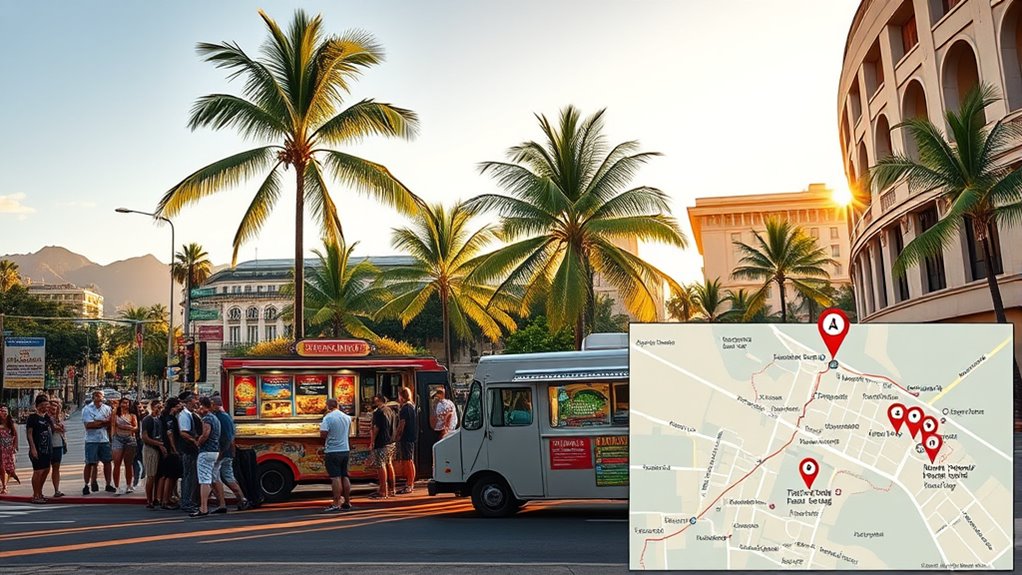
Choosing the right locations is crucial for your food truck’s success in Honolulu, as high-traffic areas can greatly boost your sales and visibility. Focus on spots with steady foot and vehicle traffic, like tourist-centric towns and scenic areas. Consider these prime spots:
- Main streets in Haleiwa and other tourist towns
- Parking lots near beaches or parks
- Near gas stations or convenience stores on busy roads
- Tourist attractions and scenic viewpoints
- Surfing beaches and event venues during peak times
Look for locations with easy access, nearby restrooms, and good signage opportunities. Ensure your chosen site complies with local zoning laws and health regulations. Researching local zoning regulations can help you avoid legal issues and find the most suitable spots. Additionally, understanding operating hours of nearby attractions or parks can help you plan your schedule for maximum customer flow. Strategic placement helps attract both tourists and locals, maximizing your customer base and profits.
Crafting a Menu That Attracts Customers and Showcases Local Flavors
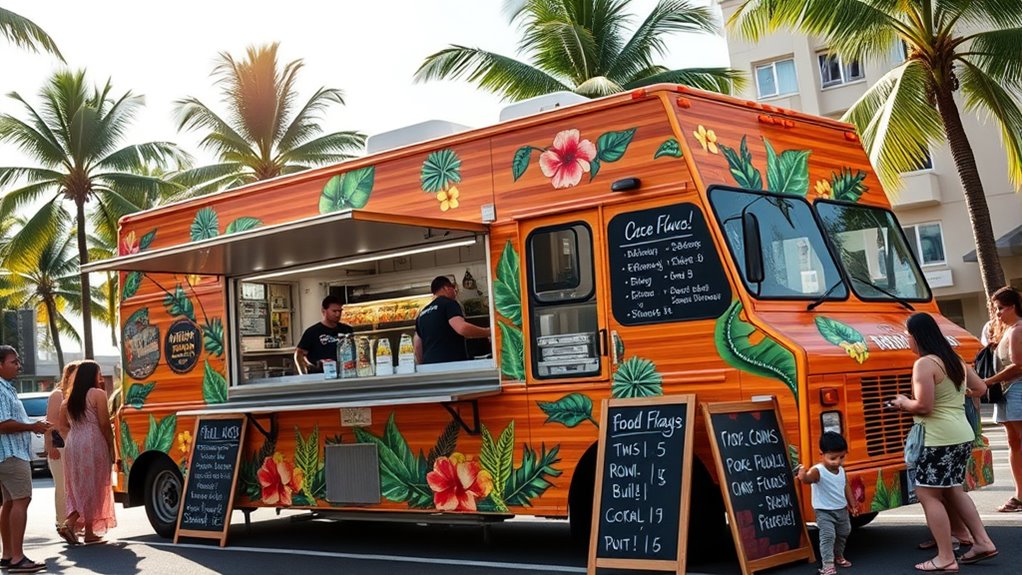
Creating a menu that attracts customers and highlights local flavors is key to standing out in Honolulu’s vibrant street food scene. Focus on native ingredients like pineapple, guava, star fruit, taro, sweet potato, and fresh seafood such as ahi tuna or kalua pork. Incorporate Hawaiian sea salt and tropical spices like pili grass and kukui nut to enhance authenticity. Balance traditional dishes like poke bowls, loco moco, and laulau with creative twists, blending Asian influences and international street food styles, such as Hawaiian BBQ tacos. Offer vegetarian and vegan options to broaden appeal. Keep your menu diverse yet manageable, featuring signature items, seasonal specials, and quick-to-eat options. Use descriptive language and colorful visuals to entice customers and emphasize the freshness and island authenticity of your offerings. Additionally, highlighting regional flavors and local ingredients can set your food truck apart in the competitive scene.
Effective Marketing Strategies to Grow Your Food Truck Business
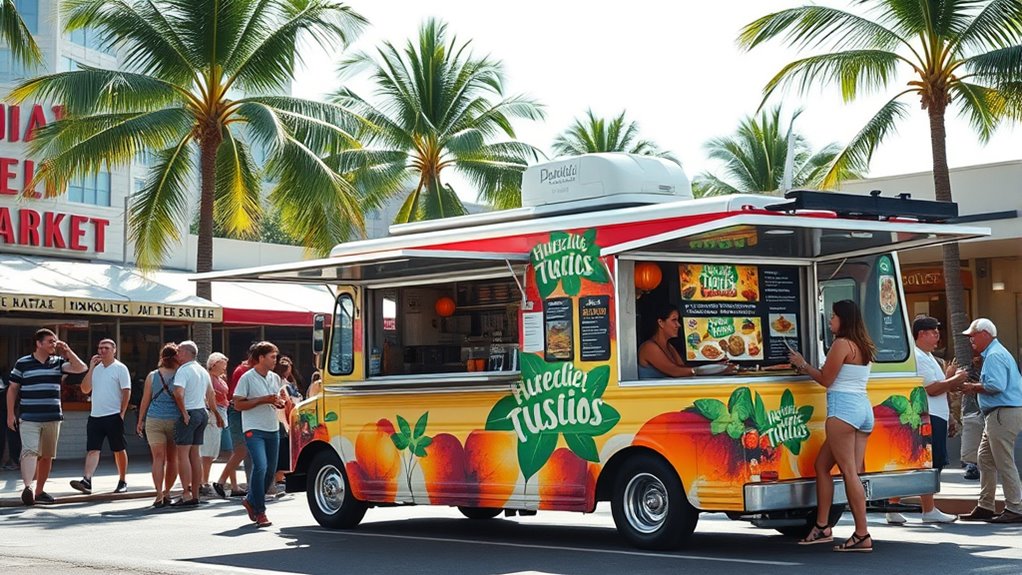
To grow your food truck business in Honolulu, leveraging social media platforms is essential. About 68% of food truck owners use social media regularly to promote their business, boosting customer engagement. Facebook is the top platform, with 75% of trucks marketing there, followed by Instagram and Twitter for visual updates. Social media advertising influences 40% of customers discovering trucks, making it a powerful customer acquisition tool. An active social presence can increase your average customer spending by 15% and boost sales by 20%. To maximize these benefits, focus on:
- Creating engaging, consistent content
- Running targeted ad campaigns
- Posting updates about locations and specials
- Encouraging customer reviews and shares
- Hosting social media-exclusive promotions
- Utilizing effective email marketing strategies can further enhance your outreach and customer retention efforts.
Frequently Asked Questions
How Long Does It Typically Take to Obtain All Necessary Permits in Honolulu?
You’ll generally need around 8 to 16 weeks to obtain all necessary permits in Honolulu. The process involves business registration, a Peddler’s License, health inspections, and food establishment permits. The timeline varies depending on application accuracy, inspector schedules, and any required corrections. To stay on track, confirm your paperwork is complete and promptly respond to inspection feedback, helping you get your food truck up and running sooner.
Are There Specific Zoning Restrictions for Operating Food Trucks on Residential Streets?
Ever wonder if you can operate a food truck right in residential neighborhoods? In Honolulu, zoning restrictions make that difficult. You can’t usually operate on residential streets without special permits or zoning changes. The city prioritizes neighborhood character, so commercial use is limited. You need permits, proof of legal parking, and must avoid proximity to homes. Violating these rules can lead to fines or towing—so, are residential streets really the best spot?
What Are the Most Cost-Effective Ways to Retrofit an Existing Truck for Honolulu’S Climate?
You can retrofit your existing truck cost-effectively by applying marine-grade, corrosion-resistant paint and sealants tailored for tropical climates. Installing modular, energy-efficient appliances and salvaging equipment helps reduce costs. Adding reflective roof coatings and insulation keeps interior temperatures low, while waterproofing electrical components prevents damage from humidity and rain. Sourcing local vendors familiar with Honolulu’s environment guarantees you get climate-ready materials at affordable prices, extending your truck’s lifespan and maintaining compliance.
Which Local Suppliers Offer the Best Deals on Fresh Seafood and Produce?
Like a navigator seeking the best treasure, you should explore Blue Seafood Company and Blue Water Shrimp for top-quality, local seafood at competitive prices. Fresh Catch and Haleiwa Seafood also offer great deals, especially if you buy in bulk or establish loyalty. For produce, visit Ono Grindz and Makeke, where local vendors provide fresh, seasonal fruits and vegetables. Direct sourcing from Hawaiian farms can further maximize your savings.
How Can I Effectively Differentiate My Food Truck in a Saturated Honolulu Market?
To stand out in Honolulu’s crowded food scene, focus on creating a unique culinary identity by blending native Hawaiian flavors with other island cultures like Japanese, Filipino, or Portuguese. Use local ingredients for signature dishes and introduce seasonal specials to keep customers coming back. Emphasize storytelling through your menu, leverage social media for marketing, and participate in popular events to boost visibility and build a loyal customer base.
Conclusion
Launching your food truck in Honolulu is like planting a vibrant seed in fertile Hawaiian soil. With the right permits, a tempting menu, and strategic spots, your business will blossom amidst the island’s lively streets. Embrace marketing like the warm trade winds guiding you forward, and watch your dream ride the waves of success. Soon, your truck will be a shining star in Honolulu’s bustling culinary sky, delighting locals and visitors alike.
